Eris is the second biggest dwarf planet located in our Solar System, and it is the most distant dwarf planet, situated beyond Neptune's orbit.
Printable Eris Worksheets
Looking for fun activities to teach kids about Eris?
This premium worksheet bundle contains a printable fact file and 10 fun and engaging worksheets to challenge your students and help them learn about Eris.
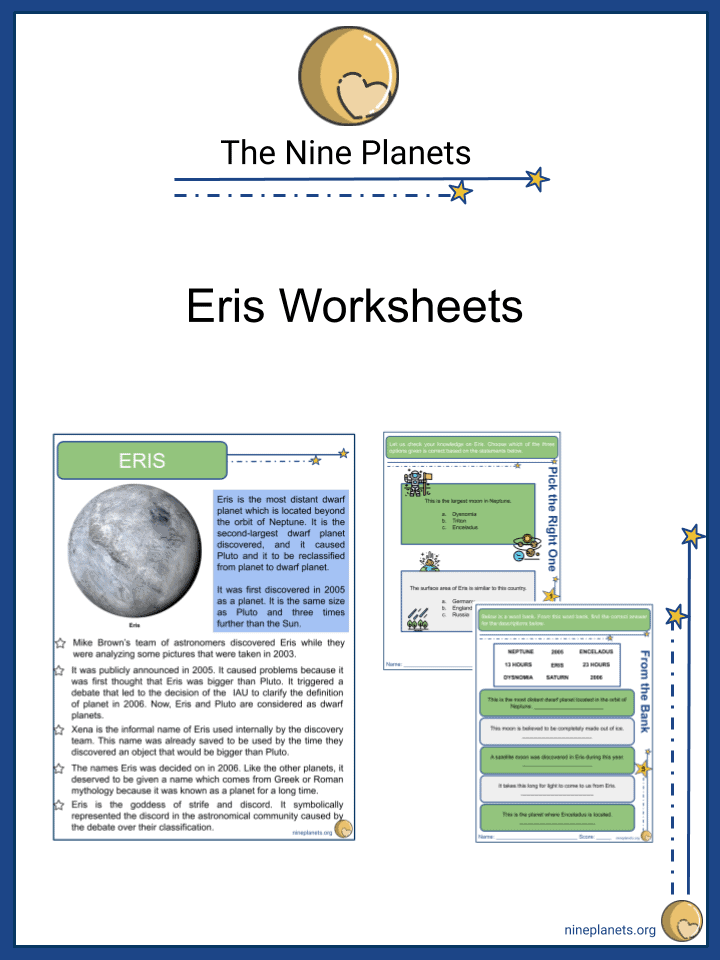
Key Facts & Summary
- Eris is located at around 97 AU away from the Sun, at its farthest point, and it comes as close as 38 AU. One AU is the distance between the Earth and the Sun.
- Eris is the second biggest dwarf planet in the Solar System, with only Pluto being slightly larger than it.
- Eris has a diameter of around 2,326 kilometers / 1,445 miles, while Pluto has a diameter of 2,376 km / 1,476 miles.
- Eris was discovered in 2005 by a team of astronomers led by Mike Brown. This same team announced Makemake's discovery on the same day, and two days later, they discovered Haumea.
- The five most famous dwarf planets in the Solar System are Pluto, Haumea, Makemake, Eris, and Ceres.
- When Eris, Haumea, and Makemake were discovered, the term "dwarf planets" came to be used.
- Pluto was initially classified as a planet, but after these three planets were discovered, all of them were reclassified as dwarf planets.
- Even though Eris is slightly smaller than Pluto, it is 28% more massive.
- Eris has a moon, which is known by the name of Dysnomia.
- Eris orbits the Sun once every 558 years. This makes one year on Eris the equivalent of 558 Earth years.
- One day on, Eris lasts longer than a day on Earth. It lasts for 25.9 hours.
- Both Eris and Pluto are smaller than our Moon.
- Eris is a very icy dwarf planet; however, when it comes closer to the Sun, the ice transforms into gas, creating an atmosphere of sorts.
- The gravity on Eris is the strongest out of all the dwarf planets.
- Currently, Eris is located at its farthest point from us. It will enter the constellation of Pisces in 2036.
Eris Dwarf Planet for Kids
Eris is the second biggest dwarf planet ever discovered, after Pluto. It was discovered in 2005, and it is named after a Greek goddess of discord.
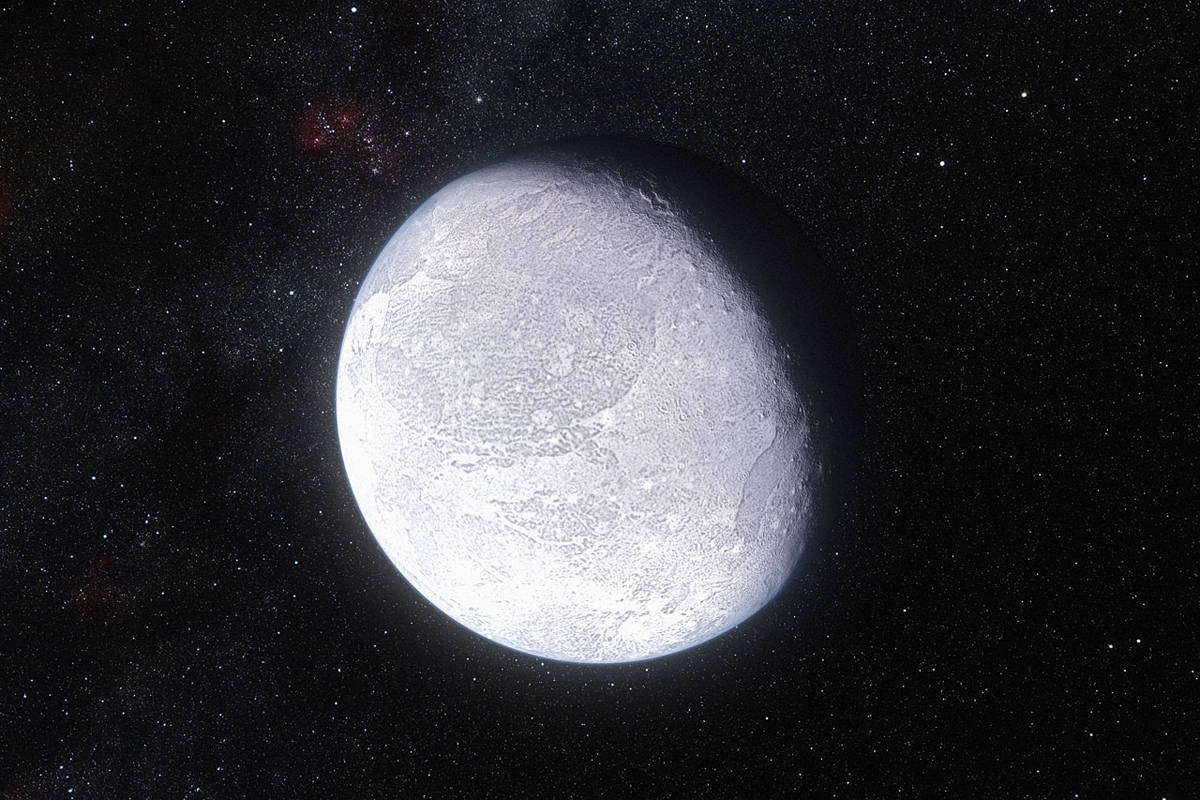
This name fits well since Eris made many astronomers argue about the definition of a planet. Eris is the most distant dwarf planet, located outside the orbit of Neptune.
Surface and Structure
Eris is very far away from the Sun, and thus, it is a very icy world. Some believe that when Eris approaches the Sun, the ice transforms into gas due to hotter temperatures. This is when Eris finally has an atmosphere, but it all changes as it gets farther away from the Sun once again.
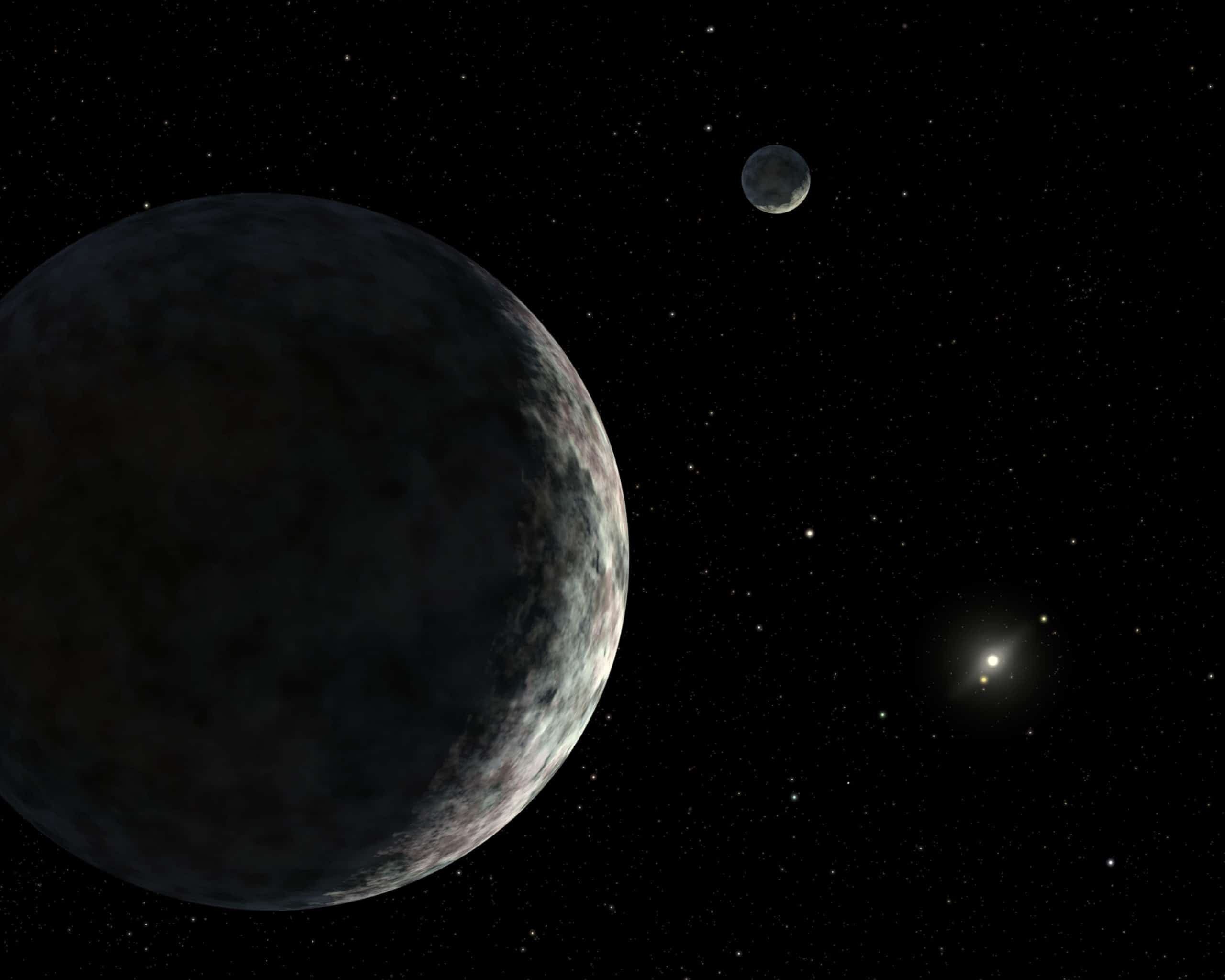
Eris has a bright surface since it is covered in ice elements, and it is mostly composed out of rocky materials. Some believe that Eris might have an underground ocean beneath its crust.
Eris's surface is similar to that of Pluto and to Triton, one of Neptune's moons. Methane ice is present, and temperatures reach -243.2 and -217.2 degrees Celsius. Nothing could survive here. Eris appears almost entirely white.
Time on Eris
Eris orbits the Sun once every 558 years. This makes one year on Eris the equivalent of 558 Earth years. One day on, Eris lasts longer than a day on Earth. It lasts for 25.9 hours. This is how long it takes for Eris to spin on its axis.
Fun Kids Facts About Eris the Dwarf Planet
- Eris is two thirds the Moon's diameter and one-third of its volume.
- All the objects located in the Asteroid Belt could fit inside Eris.
- Many believe that Eris was located inside the Kuiper Belt; however, Neptune's gravity pushed it farther away, into the scattered disc region.
- The surface size of Eris is equivalent to that of Russia.
- The gravity on Eris is 11 times weaker than the gravity on Earth. If you stood on Eris, you would be 11 times lighter.
- The moon of Eris, Dysnomia, is ten times closer to it than our Moon is to Earth.
- Temperatures on Eris are very low, and life couldn't survive there.
- Eris was first named Xena, after a warrior princess from a TV show.
- Eris was named after the goddess of discord and strife. It fits well since its discovery made many people argue about the definition of a planet, and since Pluto was declassified as a planet and classified as a dwarf planet, many people were upset. The name thus fits very well
Size and Comparison
Eris is the second biggest dwarf planet in the Solar System, with only Pluto being slightly larger than it. Eris has a diameter of around 2,326 kilometers / 1,445 miles, while Pluto has a diameter of 2,376 km / 1,476 miles.
Eris is two thirds the Moon's diameter and one-third of its volume. All the objects located in the Asteroid Belt could fit inside Eris. Here is how big the five most famous dwarf planets are:
Pluto – 2,376 kilometers / 1,476 miles
Eris – 2,326 km / 1,445 mi
Haumea – 1,632 / 1,014 mi
Makemake – 1,430 km / 888 mi
Ceres – 946 km / 587 mi
Trivia
Why is Eris Not A Planet?There are three requirements for a celestial object to be classified as a planet: it needs to orbit the Sun, it must be big enough to be rounded by its gravity, and its must clear out its orbit. Eris hasn't cleared out its orbit, and thus it can't be a planet, but it is still a dwarf planet.
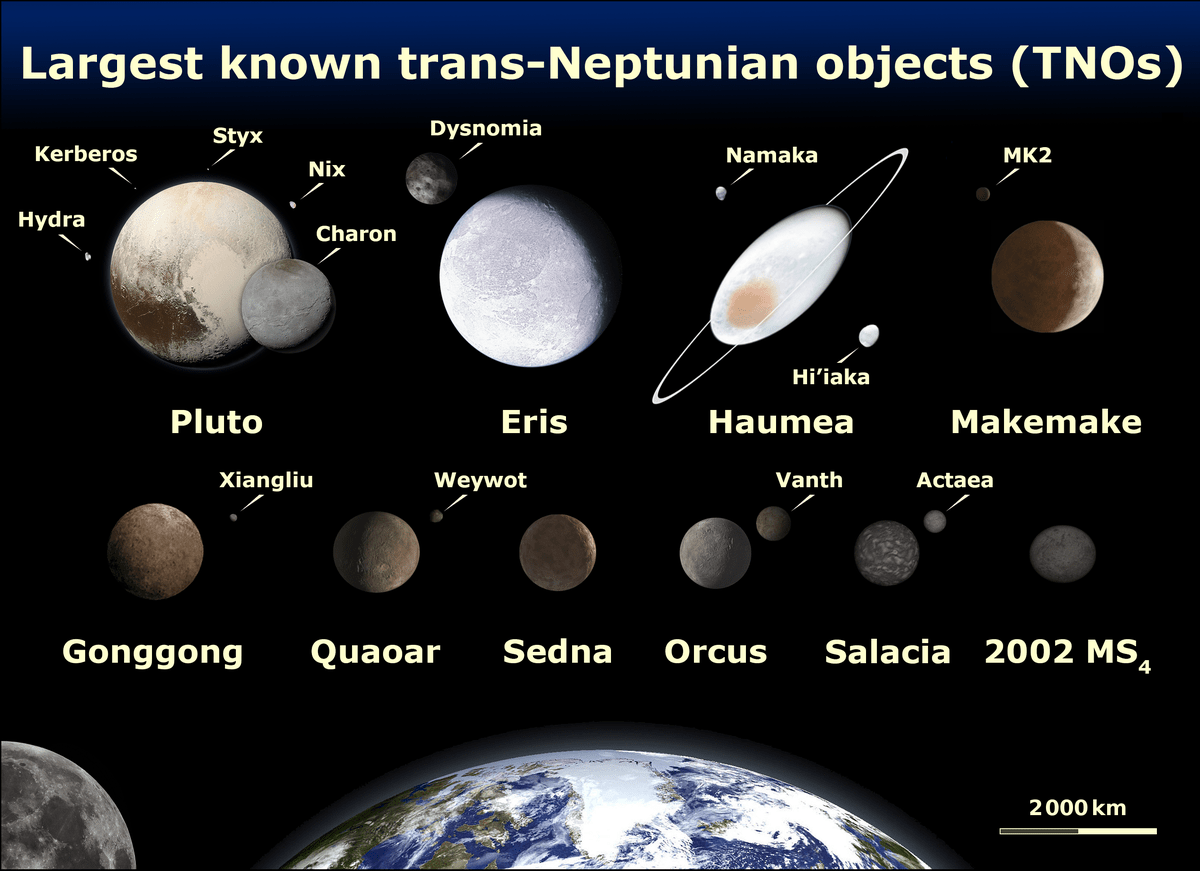
What is Eris Dwarf Planet Made Of?
Eris is mostly made out of rocky materials and nitrogen-rich ice mixed with frozen methane. This ice layer covers Eris entirely, and so it is mostly an icy world.
Does Eris Have an Atmosphere?
Eris doesn't have an atmosphere; however, when it approaches the Sun, the icy elements turn into gas. This is the only time when Eris has an atmosphere.
Is Eris Hot or Cold?
Eris is a very cold world. The temperatures on Eris are between -243.2 and -217.2 degrees Celsius. Nothing can survive here, as it is far too cold.
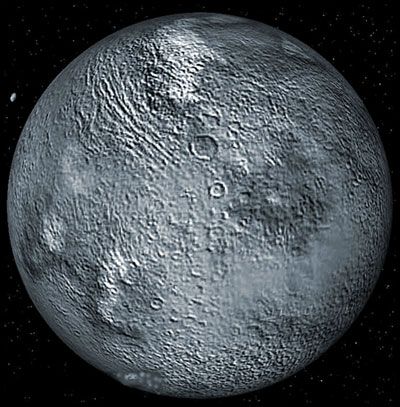
Other Characteristics of Eris
Eris has one Moon named Dysnomia. It is 650 km / 403 miles in diameter, and it is very close to Eris, at only 37,000 km / 22,990 mi. No mission was sent to Eris, however, if one spacecraft would have such a mission, it would take around 24 years to reach this icy world.
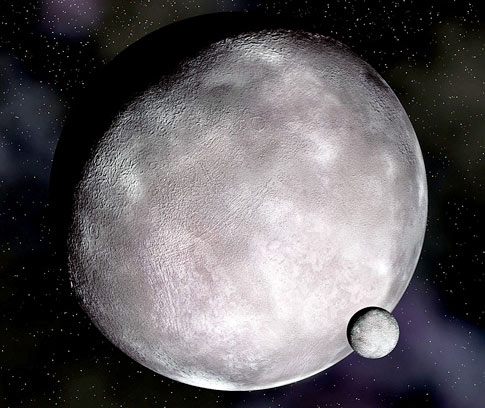
Eris Notes
Eris is the second biggest dwarf planet after Pluto; however, it is still 27% more massive than Pluto even if it's slightly smaller.
- Eris has only one moon, Dysnomia. It is the second biggest moon in relation to its parent planet, after Pluto's moon Charon.
- Eris doesn't have an atmosphere, but when it approaches the Sun, the ice turns into gas, and this is when it has a temporary atmosphere.
- Eris is a very cold world, and nothing would survive here.
- Eris is the most distant dwarf planet in the Solar System.
- The discovery of Eris, Makemake, and Haumea, led to Pluto's declassification and the creation of a new class of celestial objects, namely dwarf planets.
- Eris was discovered in 2005 by a team of astronomers led by Mike Brown. This same team announced Makemake's discovery on the same day, and two days later, they discovered Haumea.
- Eris is usually located in the scattered disc region.
Sources:
Image Sources:
- https://cdn.mos.cms.futurecdn.net/ufTfK2rbpQXZBjt2ZPsm57.jpg
- https://cdn.mos.cms.futurecdn.net/dZqUSGT8ZrMagExRfcrKLJ.jpg
- https://upload.wikimedia.org/wikipedia/commons/thumb/9/91/EightTNOs.png/1200px-EightTNOs.png
- https://i.pinimg.com/originals/57/94/79/579479fe64be3588c636637785c604d6.jpg
- https://astronomy.com/~/media/A8DC586B5A4C425C885406F1C7986B7C.jpg
